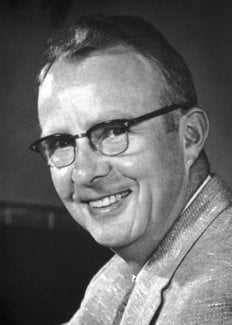Luis Alvarez
Biographical

Luis W. Alvarez was born in San Francisco, Calif., on June 13, 1911. He received his B.Sc. from the University of Chicago in 1932, a M.Sc. in 1934, and his Ph.D. in 1936. Dr. Alvarez joined the Radiation Laboratory of the University of California, where he is now a professor, as a research fellow in 1936. He was on leave at the Radiation Laboratory of the Massachusetts Institute of Technology from 1940 to 1943, at the Metallurgical Laboratory of the University of Chicago in 1943-1944, and at the Los Alamos Laboratory of the Manhattan District from 1944 to 1945.
Early in his scientific career, Dr. Alvarez worked concurrently in the fields of optics and cosmic rays. He is co-discoverer of the “East-West effect” in cosmic rays. For several years he concentrated his work in the field of nuclear physics. In 1937 he gave the first experimental demonstration of the existence of the phenomenon of K-electron capture by nuclei. Another early development was a method for producing beams of very slow neutrons. This method subsequently led to a fundamental investigation of neutron scattering in ortho- and para-hydrogen, with Pitzer, and to the first measurement, with Bloch, of the magnetic moment of the neutron. With Wiens, he was responsible for the production of the first 198Hg lamp; this device was developed by the Bureau of Standards into its present form as the universal standard of length. Just before the war, Alvarez and Cornog discovered the radioactivity of 3H (tritium) and showed that 3He was a stable constituent of ordinary helium. (Tritium is best known as a source of thermonuclear energy, and 3He has become of importance in low temperature research.)
During the war (at M.I.T.) he was responsible for three important radar systems – the microwave early warning system, the Eagle high altitude bombing system, and a blind landing system of civilian as well as military value (GCA, or Ground-Controlled Approach). While at the Los Alamos Laboratory, Professor Alvarez developed the detonators for setting off the plutonium bomb. He flew as a scientific observer at both the Almagordo and Hiroshima explosions.
Dr. Alvarez is responsible for the design and construction of the Berkeley 40-foot proton linear accelerator, which was completed in 1947. In 1951 he published the first suggestion for charge exchange acceleration that quickly led to the development of the “Tandem Van de Graaf accelerator”. Since that time, he has engaged in high-energy physics, using the 6 billion electron volt Bevatron at the University of California Radiation Laboratory. His main efforts have been concentrated on the development and use of large liquid hydrogen bubble chambers, and on the development of high-speed devices to measure and analyze the millions of photographs produced each year by the bubble-chamber complex. The net result of this work has been the discovery by Dr. Alvarez’ research group, of a large number of previously unknown efundamental particle resonances.. Since 1967 Dr. Alvarez has devoted most of this time to the study of cosmic rays, using balloons and superconducting magnets.
Professor Alvarez is a member of the following societies: National Academy of Sciences, American Philosophical Society, American Physical Society (President 1969), American Academy of Arts and Sciences, and National Academy of Engineering. In 1946 he was awarded the Collier Trophy by the National Aeronautical Association for the development of Ground – Controlled Approach. In 1953 he was awarded the John Scott Medaland Prize, by the city of Philadelphia, for the same work. In 1947 he was awarded the Medal for Merit. In 1960 he was named “California Scientist of the Year” for his research work on high-energy physics. In 1961 he was awarded the Einstein Medal for his contribution to the physical sciences. In 1963 he was awarded the Pioneer Award of the AIEEE; in 1964 he was awarded the National Medal of Science for contributions to high-energy physics, and in 1965 he received the Michelson Award. He has received the following honorary de grees: Sc.D., University of Chicago, 1967; Sc.D., Carnegie-Mellon University, 1968; Sc.D., Kenyon College, 1969.
This autobiography/biography was written at the time of the award and first published in the book series Les Prix Nobel. It was later edited and republished in Nobel Lectures. To cite this document, always state the source as shown above.
For more updated biographical information, see:
Alvarez, Luis W., Adventures of a Physicist. Basic Books, New York, 1987.
Luis Alvarez died on September 1, 1988.
Nobel Prizes and laureates
Six prizes were awarded for achievements that have conferred the greatest benefit to humankind. The 14 laureates' work and discoveries range from quantum tunnelling to promoting democratic rights.
See them all presented here.
